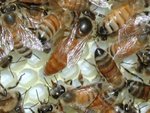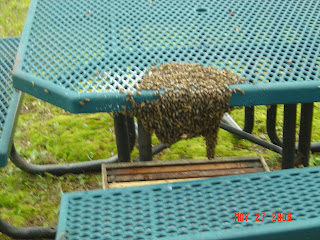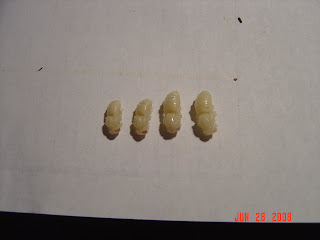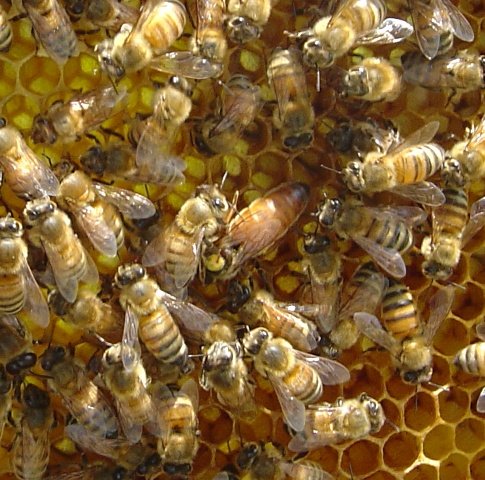Left: A wild swarm of bees we removed from a picknic table at the local conservation area. As you can see, this swarm was very small.
.
.
.
.
.
.
.
.
.
As you can see from previous entries, I started 2008 with only 3 surviving hives, out of 10 strong wintered over hives from the previous fall. With much effort I built those three hives into 8, while harvesting 60 lbs of honey, and rearing about 20 queens. Some of those queens failed, some are now reining in my hives, and some of the better queens were sold to fellow local beekeepers here on the cape. We had a great time with the bees this year.
The bees are sure amazing architects!
.
.
.
.
.
.
.
.
.
.
.
.
.
.
.
.
.
.
Some of our adventures included gathering two wild swarms. One was found in the middle of a local conservation area, attached to the corner of a metal picnic table. The site was right against one of the capes largest ponds in the middle of nowhere. The swarm was probably two miles from the nearest beehive. I think the swarm was from a wild hive.
Left: A close up of the swarm, now acutaly an established colony. Where is the queen? We did find her (by luck) and put her into the new hive. Click on the photo for an enlarged view
.
.
.
.
.
.
.
.
.
The other swarm was gathered from a storage shed at the Otis Air Force Station, right next to the airstrip. The swarm had established itself inside the storage shed, accessing their new home through rusted holes in the siding. Comb had been built attached to various packs and boxes which contained who knows what. We spent a good part of a day removing items to access the bees. They had built beautiful curved comb attached to the metal siding of the shed, and everything else. In a way, it was a shame to remove them. It took us a while to cut out the comb and attached bees and install them into a hive. What a challenge. Bees were flying and honey was dripping everywhere. We neglected to bring a bucket to put the extra honeycomb in, so we used an empty rifle locker. Bees were stuck to everything!
.
Right: My first attempt a queen rearing this spring. See how small the cells are. I destroyed all these cells and started over. These cells were dry grafted. On my next attempt I primed the cups and got a 85% acceptance rate.
.
.
.
.
.
.
The biggest challenge I had this year was keeping the bees in the mating nucs. I had about a 60 percent success rate with keeping the bees in a nuc. Some would abscond, or return to the parent colony, or migrate to a neighboring nuc. I had two nice queens, and established colonies abscond due to small hive beetle infestation. As we discussed at the bee association, this pest is increasingly becoming a problem. I believe my beetle problem came with the packages of bees I received from Georgia two years ago. They have increased unchecked for two years, and I saw many of them in my hives.
.
Left: Removed queen pupa. These queens are all the same age. You can see how the cell size effects the development of the queen. Larger queen cells mean larger queens. Larger queens mean more overies and better laying.
.
.
.
.
.
I was just thinking today that the 2009 beekeeping season has already started. The work we do in preparing the hives for winter will have a great effect on the condition of the bees this spring. This year some of the hives have been wrapped in black building paper. It is my understanding that the wrapped hives will be about 5 degrees warmer than the unwapped hives. We will see how this works out.
.
Right: This is what it is all about.... The beekeepers reward.... Honey right from the extractor. We harvested 60 lbs this year.
Right: This is what it is all about.... The beekeepers reward.... Honey right from the extractor. We harvested 60 lbs this year.
.
.
.
.
.
.
.
.
My new years resolution is to maintain this blog. If you read this, post a message. Let me know what you think.
.
Right: My friend, and fellow beekeeper, Gene and I on extraction day!
.
.
.
.
.
.
.
.
.
.
.
And have a happy new year!













